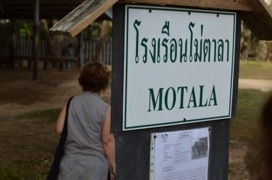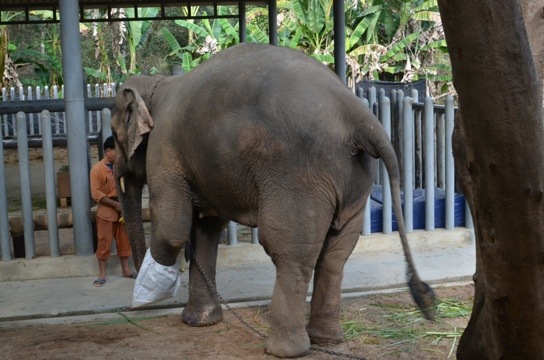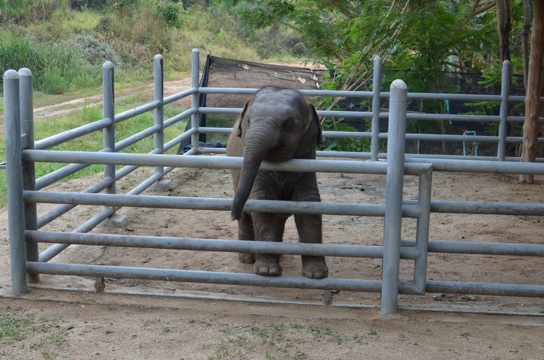Bumping and jostling on roads as wild and bumpy as an elephant’s hide, we arrived in the heat of morning at the Asian Elephant hospital, captained by the redoubtable Dr. Soraida. Sickly her whole life, she had a sympathy with the plight of the exploited, wounded elephants of Thailand, and didn’t understand – even as a girl – why there was no place to help or heal them.
You’d think the wild elephants, left to wander the jungles of Thailand, would be the safest, healthiest elephants. Due to the long border wars between Myanmar (then Burma) and Thailand, the mountain jungles on their borders are still laced with unexploded and unattended-to land mines. Elephants, unfortunately, can survive stepping on a land mine with their great feet.
The star, in some ways, of the elephant hospital, Motala, lost the lower 30cm or so of her foot to infection after stepping on a land mine. Dr. Soraida imagined posts for elephants to rest their legs on, and they have developed prosthetics with the extremely sweet Dr. Preecha (sp!) so that the Motala can walk.
Dr. Soraida stared straight at me when we sat down, as if to say, “And you, what do you want from the elephants?” I don’t want anything in particular from them, and was working hard during our walkabout on the grounds to be an open presence, moving love and support through my system. “I am not a vet, not an elephant doctor,” she announced proudly, “so I had this weird idea that we could save them. Help them. Like we do for people.”
The sky was thick with kind clouds and the air was cooler than it had been. The elephants seemed happy, if wary. There is a baby elephant, playful, cute, wanting to run free, like a dog with wagging and shaking his trunk.
“Elephants I don’t know how they know, but they know we want to help them,” Dr. Soraida explained about the elephant Motala. “She was in a lot of pain. The vets were afraid to treat her. I went up to her, stroked her face. I told her, ‘we are trying to help you’. She knew. She understood. A big tear,” and Dr. Soraida traces a long path down her cheek, slowly.
The baby elephant made eye contact, chirped, looked significantly at the closed (massive, thick) gate to his enclosure. Another elephant with an infection in its head from a wound from an elephant hook eyed me continuously as I took her picture, the kind of watchfulness that is universal to those in pain and turned to victimhood by abuse.
The trunks of elephants remind me of squid tentacles – but not in a bad way. 1100 muscles, and stronger even in a young elephant than my entire body, and yet…
there is a kind of finger at the end, and the young female elephant we were feeding peanuts… she probed our hands with a gentle snuffling, tapped at pockets as if to say, “you could get more peanuts, do you have more? do you love peanuts like I do?”
And when you hold out your open palm, the great nostrils find the peanuts cradled there. The dry, rough skin drops with gentleness on your hand. The fingers scoops, tickling with an inbreath to hold the peanuts in place and the *shoom* the peanuts vanish into the triangular pink mouth. And the trunk is searching your pockets, playful.
I need a trunk.


